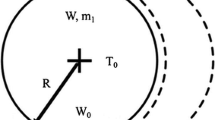Abstract
In this study the enhancement effect of adsorption mass transfer by acoustic wave is investigated to understand how the acoustic wave influences the adsorption performance. The experimental data were obtained to show the behavior of silica-gel adsorption with/without acoustic field. The experimental results showed the adsorption speed with acoustic wave became higher than that without acoustic wave although the equilibrium adsorption amount was kept to be the same. From the viewpoint of acoustic wave conditions, the adsorption speed was increased with increasing the velocity amplitude, while the pressure amplitude had no effect on the enhancement. The maximum adsorption speed attained five times as high as the case without acoustic wave when the velocity amplitude was 1.35 m/s. Background air flow velocity is also an influential factor. The experimental results support that the non-dimensional ratio of the velocity amplitude to the background flow velocity is essential to describe the enhancement effect. Based on the observed data, an empirical formula was estimated to express the relationship between the enhancement effect and the non-dimensional velocity amplitude. The liner regression showed the good agreement and gave the critical non-dimensional velocity amplitude of 1.9 over which acoustic wave is effective to amplify the mass transfer rate of adsorption.








Similar content being viewed by others
Abbreviations
- a :
-
Regression coefficient
- f :
-
Frequency (Hz)
- k m1 :
-
Mass transfer coefficient without acoustic wave (1/s)
- k m2 :
-
Mass transfer coefficient with acoustic wave (1/s)
- P :
-
Pressure amplitude (kPa)
- q :
-
Adsorption amount (g/kg)
- q*:
-
Equilibrium adsorption amount (g/kg)
- R :
-
Enhancement effect (= km2/km1) (−)
- RH :
-
Relative humidity (%)
- T :
-
Temperature (°C)
- t :
-
Time (s)
- U :
-
Velocity amplitude (m/s)
- U 0 :
-
Critical velocity amplitude (m/s)
- U*:
-
Non-dimensional velocity amplitude (= U/V0) (−)
- V :
-
Air velocity (m/s)
- V 0 :
-
Background flow velocity (m/s)
- ω:
-
Angular frequency (1/s)
References
Alam, K.C.A., Saha, B.B., Akisawa, A., Kashiwagi, T.: Optimization of a solar driven adsorption refrigeration system. Energy Convers. Manag. 42(6), 741–753 (2001)
Alam, K.C.A., Saha, B.B., Akisawa, A.: Adsorption cooling driven by solar collector: a case study for Tokyo solar data. Appl. Therm. Eng. 50(2), 1603–1609 (2013)
Biwa, T.: Beginner’s guide to measurement techniques in thermoacoustic systems. Teion Kogaku 43(12), 517–526 (2008) (in Japanese)
Crank, J.: The Mathematics of Diffusion. Clarendon Press, Oxford (1975)
Fusco, A., Ward, W., Swift, G.: Two-sensor power measurements in lossy ducts. J. Acoust. Soc. Am. 91, 2229–2235 (1992)
Ge, T.S., Li, Y., Wang, R.Z.: A review of the mathematical models for predicting rotary desiccant wheel. Renew. Sustain. Energy Rev. 12(6), 1485–1528 (2007)
Kakiuchi, H., et al.: Water vapor adsorbent FAM-Z02 and Its applicability to adsorption heat pump. Kagaku Kogaku Ronbunshu 31, 273–277 (2005) (in Japanese)
Kodama, A., Hirayama, T., Goto, M., Hirose, T., Critoph, R.E.: The use of psychrometric charts for the optimisation of a thermal swing desiccant wheel. Appl. Therm. Eng. 21(16), 1657–1674 (2001)
Mitsubishi Chemical Holdings Corporation: KAITEKI Report corporate social responsibility, 41–45 (2011) (in Japanese)
Rambhad, K.S., Walke, P.V., Tidke, D.J.: Solid desiccant dehumidification and regeneration methods—a review. Renew. Sustain. Energy Rev. 59, 73–83 (2016)
Saha, B.B., Boelman, E.C., Kashiwagi, T.: Computational analysis of an advanced adsorption-refrigeration cycle. Energy 20(10), 983–994 (1995)
Saha, B.B., Akisawa, A., Kashiwagi, T.: Solar/waste heat driven two-stage adsorption chiller: the prototype. Renew. Energy 23(1), 93–101 (2001)
Wang, Y.H., Zhu, J.L., Zhao, C.G., et al.: Removal of trace organic compounds from wastewater by ultrasonic enhancement on adsorption. Desalination 186(1), 89–96 (2005)
Yao, Y., Yang, K., Liu, S.: Study on the performance of silica gel dehumidification system with ultrasonic-assisted regeneration. Energy 66(1), 799–809 (2014)
Author information
Authors and Affiliations
Corresponding author
Rights and permissions
About this article
Cite this article
Akisawa, A., Okubo, Ki., Iguchi, K. et al. Effect of acoustic wave on the enhancement of moisture adsorption of silica-gel. Adsorption 24, 595–600 (2018). https://doi.org/10.1007/s10450-018-9970-1
Received:
Revised:
Accepted:
Published:
Issue Date:
DOI: https://doi.org/10.1007/s10450-018-9970-1




